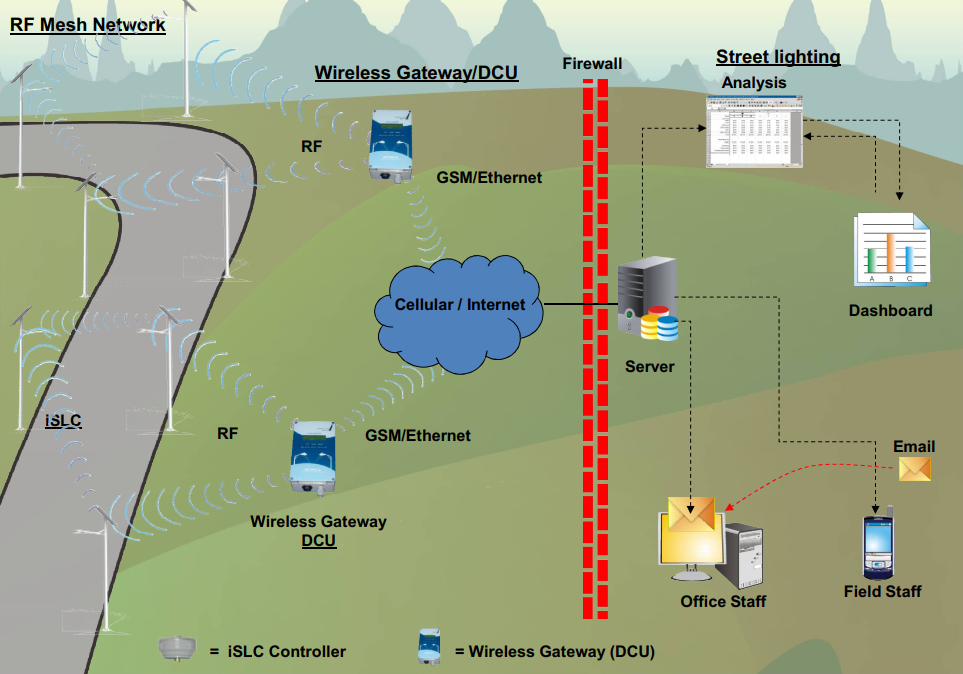
TellCo Europe Street Lighting Remote Control Management System (TRLCS)
Streetlights are a major source of revenue drain for all cities and if not properly maintained, canresult in lot of inconvenience to the citizens. Also streetlights, if left ON for long times, can adversely impact the environment. TellCo Europe partnering with a third party USA based company who solved all the above problems.

Key Benefits
It is a centralized streetlight management solution that is powerful yet economical enough to provide quick ROI based on the following:
- Reduce energy costs
- Reduce maintenance costs
- Low-cost wireless control
- Energy Monitoring
- Increased lamp lifes
- Sun-set/Sun-rise based ON/OFF schedule
- Powerful web-based software with GPS mapping
- Powerful Asset Management with complete and accurate streetlight inventory
- Extensive reporting on the performance and energy savings and more
The system offers several products to address the specific needs and budgets of different agencies. These product ranges from extremely low cost controllers that can replace digital timers on individual poles to complete streetlight system that control power to a large group of streetlights.
Features
Wireless Technology:
The system utilizes the latest developments in wireless technology and employs RF/GSM technology to program; monitor and control geographically distributed remote streetlights.
Simple and Easy Remote Monitoring:
Streetlights are equipped with controllers that contain communication and monitoring modules that provide regular streetlight status updates to the Master Control Station (MCS).
Local and Remote Control:
The streetlight control system provides as many as five control modes for controlling the light bulbs that can be remotely programmed from a web based software. Lamps can be remotely controlled based on a user configurable ON and OFF schedule that can be programmed on daily / monthly / yearly basis or can be controlled locally based on an astro-clock that accurately calculates sunset and sunrise times using location and time zone data throughout the year. Thus the street lights continue to be operated even when the communication link fails.
Faulty Monitoring:
Extensive fault monitoring is provided based on intelligent correlation of data to report lamp status, communication failure and more. All faults are sending to the MCS that generates alarms for visualization and fault rectification.
Dimming of Lights (Optional):
The system can be programmed to dim the streetlights during the night time to reduce energy consumption. However, this is only possible in case streetlights are capable of being dimmed. It also offers facility to program the controller to switch on/off as alternate groups of streetlights.
Burn Hours:
The system can track lamp burn hours that can be used for predictive maintenance allowing lamp replacement to be planned in advance.
Flexible for Expansion:
The system can easily be expanded to include new locations and streetlights.
Report Generation:
The Master Control Station generates various detailed real-time reports. It also helps to maintain history of events.

Advantages of Streetlight Automation
Power Saving:
The ON/OFF switching of the streetlights can be remotely programmed and re-programmed as per requirement so as to save valuable power. Intelligent interface devices can optimize the energy requirements by recording the changes in nightfall in different seasons.
Reduce Operating Cost:
The system utilizes wireless communication techniques and offers real time surveillance of individual group of junction boxes and lamps.
Low Annual Maintenance Cost:
The unmatched precise and accurate information on electricity consumption helps to plan preventive maintenance and reduces maintenance cost per pole by a significant level.
Future Addition Made Easy:
The system utilizes wireless mode of data communication and saves the cost and labor of cable lying throughout the busy roads. This improves the scalability of the system to a new height. Any number of new streetlights can be added to the existing network with simple and easy modifications.
Low Initial Cost:
Absence of cable lying brings down the execution cost and saves initial installation cost.
A typical Streetlight Automation Control system configuration for this project is as shown in the figure below. The diagram shows a typical schematic of the streetlight management system wherein data from individual controllers is communicated back to the control room for remote monitoring and control.
